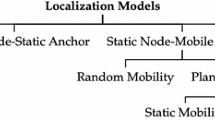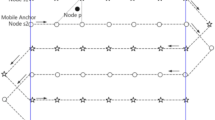Abstract
Localization is one of the most important challenges of wireless sensor networks because the location information is typically used in other domains such as coverage, deployment, routing, and target tracking. There exist some localization algorithms that facilitate the sensor nodes to locate itself using the mobile anchor node position. Some crucial attempts have been made in the past for optimizing the mobile anchor node trajectory with good accuracy. This paper presents a novel path planning scheme, D-connect, which ensures the localization of all the sensor nodes with minimum trajectory length. The performance of the proposed scheme is evaluated through a series of simulations. Experimental results reveal that the shortest path for traversing the whole area can be traced with the minimum localization error using this method. It also shows that D-connect outperforms the existing methods in terms of the anchor node trajectory length as well as the localization error.












Similar content being viewed by others
References
Akyildiz, I. F., Su, W., Sankarasubramaniam, Y., & Cayirci, E. (2002). A survey on sensor networks. IEEE Communications Magazine, 40(8), 102–114.
Munir, S. A., Ren, B., Jiao, W., Wang, B., Xie, D., & Ma, J. (2007). Mobile wireless sensor network: Architecture and enabling technologies for ubiquitous computing. In Proceedings of the 21st International Conference on Advanced Information Networking and Applications Workshops (AINAW07), USA, May 21–23, 113–120.
Nazir, U., Arshad, M. A., Shahid, N., & Raza, S. H. (2012). Classification of localization algorithms for wireless sensor network: A survey. In Proceedings of the IEEE International Conference on Open Source Systems and Technologies (ICOSST), Lahore, Pakistan, Dec 20–22, 1–5.
Baggio, A., & Langendoen, K. (2006). Monte-carlo localization for mobile wireless sensor networks. In Proceedings of the Mobile Ad-hoc and Sensor Networks, Hong Kong, China, December 13–15, 317–328.
Sheu, J.-P., Hu, W.-K., & Lin, J.-C. (2010). Distributed localization scheme for mobile sensor networks. IEEE Transactions on Mobile Computing, 9(4), 516–526.
Kim, K., Kim, H., & Hong, Y. (2009). A self localization scheme for mobile wireless sensor networks. In Proceedings of the IEEE Fourth International Conference on Computer Sciences and Convergence Information Technology, Seoul, TBD, Korea (South), Nov 24–26, 774–778.
Sichitiu, M. L., & Ramadurai, V. (2004). Localization of wireless sensor networks with a mobile beacon. In Proceedings of the IEEE International Conference on, Mobile Ad-hoc and Sensor Systems, Fort Lauderdale, FL, USA, Oct 25–27, 174–183.
Hu, Z., Gu, D., Song, Z., & Li, H. (2008). Localization in wireless sensor networks using a mobile anchor node. In Proceedings of the IEEE/ASME International Conference on Advanced Intelligent Mechatronics (AIM), Xian, China, Jul 2–5, 602–607.
Bahi, J. M., Makhoul, A., & Mostefaoui, A. (2008). Hilbert mobile beacon for localisation and coverage in sensor networks. International Journal of Systems Science, 39(11), 1081–1094.
Rezazadeh, J., Moradi, M., Ismail, A. S., & Dutkiewicz, E. (2014). Superior path planning mechanism for mobile beacon-assisted localization in wireless sensor networks. IEEE Sensors Journal, 14(9), 3052–3064.
Koutsonikolas, D., Das, S. M., & Hu, Y. C. (2007). Path planning of mobile landmarks for localization in wireless sensor networks. Computer Communications, 30(13), 2577–2592.
Jiang, J., Han, G., Xu, H., Shu, L., & Guizani, M. (2011). Lmat: Localization with a mobile anchor node based on trilateration in wireless sensor networks. In Proceedings of the IEEE Global Telecommunications Conference (GLOBECOM), Houston, TX, USA, Dec 5–9, 1–6.
Munoz, D., Lara, F. B., Vargas, C., & Enriquez-Caldera, R. (2009). Position location techniques and applications. New York: Academic Press.
Shang, F., Su, W., Wang, Q., Gao, H., & Fu, Q. (2014). A location estimation algorithm based on RSSI vector similarity degree. International Journal of Distributed Sensor Networks, 2014, 371350. doi:10.1155/2014/371350.
Sahu, P. K., Wu, E. H.-K., & Sahoo, J. (2013). DuRT: dual RSSI trend based localization for wireless sensor networks. IEEE Sensors Journal, 13(8), 3115–3123.
Sarkar, T. K., Ji, Z., Kim, K., Medouri, A., & Salazar-Palma, M. (2003). A survey of various propagation models for mobile communication. IEEE Antennas and Propagation Magazine, 45(3), 51–82.
Rappaport, T. S., et al. (1996). Wireless communications: Principles and practice. Upper Saddle River, NJ: Prentice Hall PTR.
Mondal, K., Karmakar, A., & Mandal, P. S. (2016). Path planning algorithms for mobile anchors towards range-free localization. Journal of Parallel and Distributed Computing, 97, 35–46.
Acknowledgements
The authors would like to thank Dr. Ankit Dubey, Assistant Professor, Department of Electronics and Communication Engineering, National Institute of Technology Goa, India for his valuable and constructive suggestions during the development of this research work.
Author information
Authors and Affiliations
Corresponding author
Rights and permissions
About this article
Cite this article
Sabale, K., Mini, S. Anchor node path planning for localization in wireless sensor networks. Wireless Netw 25, 49–61 (2019). https://doi.org/10.1007/s11276-017-1538-6
Published:
Issue Date:
DOI: https://doi.org/10.1007/s11276-017-1538-6




